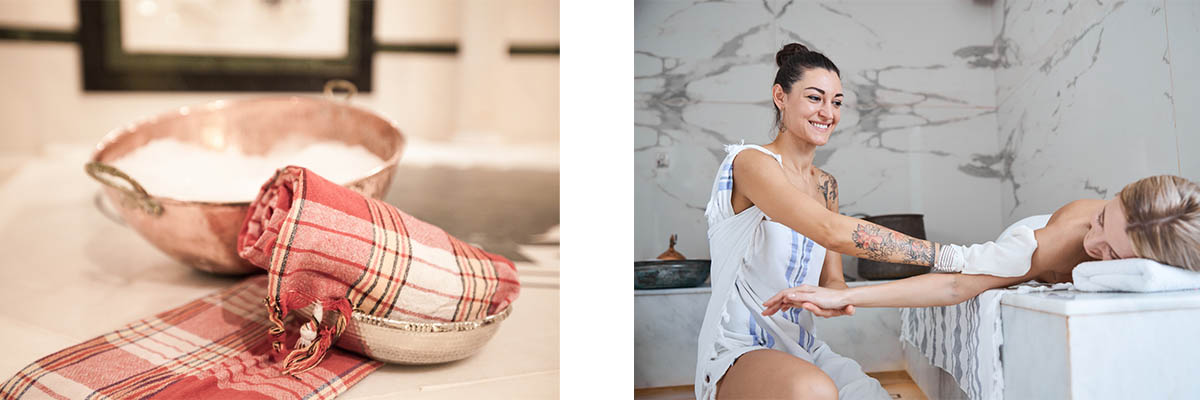Spa & Wellbeing
Hammam Culture and Spa
31.05.2022

In the ancient times, the hammam was a place where various social activities were carried out in addition to bathing oneself.
It was also used as a place for massages, manicure, treatment and exercises. As a result, it is not surprising that hammam has made its way into our culture and has found a place on spa menus. In this article we gathered the history of hammam culture, its various usages and its relationship with spas.
A hammam is defined as a place where “one can bathe, cleanse and find remedy”. The use of water, the most basic element of our vital necessities, for health service purposes led to the construction of water spaces such as hammams and hot springs. In any period, hammams, shaped in accordance with the religious and cultural beliefs of the communities, have been a part of social life. The hammam concept which emerged in the Ancient Rome, came up with its different forms as it spread over Europe and had a significant impact on the cultures of Sumerian, Egyptian, Greek, and Asian people.
Moroccan Hammam, which focuses on relaxation and cleansing, is the first hammam culture to arrive in the West from the Middle East. Even in our day, Moroccans go to the hammam once a week, spend long hours there, and follow the old care routines. Moroccan hammam is a bath ritual focused on steam. While steam softens the skin, it relaxes the mind and deeply cleans pores. As care products they usually use olive oil and eucalyptus-based black soap and the skin is cleaned using a bath glove or normal glove. After this cleansing Moroccan mint tea is served.

The sweating caused by high moisture in hammams stimulates metabolism movements. This steam bath area is divided into five different sections namely; changing area, cooling area, hammam and furnace. Different cultures have observed the therapeutic effect of moist warm areas for over a century. Modern treatments of a lot of illnesses today include warm applications and steam. Hammams are especially important for having the features of steam baths and at the same time housing a lot of traditional and new treatments.
Old Turkish hammams are a reflection of Turkish collective society’s culture, both in the way they function and in concept. Before Istanbul became the shining capital of the Ottoman Empire for 1500 years it was a part of the Byzantine and Roman Empires as Constantinople. This situation allowed the Ottoman Empire to meet the Roman hammam culture.
In the 14th century the most famous first Turkish hammams, which were in the kulliyes started to be built by Mimar Sinan, are without a doubt the hammams ordered by Nurbanu Sultan: Cemberlitas Hammam, Kilic Ali Pasa Hammam and Cagaloglu Hammam. Hammams, which were generally used by women in the Ottoman society, to come together, chat and spend time to socializing and talking about current situations were not only important for their architecture and the activity of bathing themselves but also for their traditions. Today when we talk about hammams in Turkey, the first place that comes to mind is Hagia Sophia Hurrem Sultan Hammam.

Hammam has been known in Turkish culture since the Turkish people migrated from Anatolia to the Middle East as a place where special days and celebrations are realized, and these traditions are still practiced today. The most popular of these traditions that are still applied today is without a doubt, the bride and groom hammams. However, these two have some different features. Bath gloves and bath foam are typically applied at both parties, but after the henna party, moisturizers with herbal essences and body clay masks are applied in the bride's hammam. Massage application with aromatherapy and judas tree extract is a tradition that came from the Sultan’s room and is applied in the groom's hammam.
The Spa (Salus Per Aquam) encompasses all treatments that make use of the holistic healing power of water. Spa that combines cosmetic, therapeutic and healing applications with water and health also appears as an application in hammam. Hot-cold water application, steam bath, resting on a warm marble stone, peeling, bath glove application, foam bath, body cares applied with essential oils and herbal contents, cellulitis, drainage, relaxing and treating massages can be given as examples of these applications.
There are special hammam rituals that include peeling and massage care together with organic ingredients as well. These rituals are among the signature treatments on some of the spa center menus. The 75-minute “Kaplankaya Signature Hammam'' offered in the Wellness therapy category in the Six Senses Kaplankaya menu is one of the most beautiful examples of this.
Hammams, which go way beyond the purpose of cleaning and bathing oneself, also help with calming our minds and cleansing our bodies and spirits. You can use the hammams we mentioned to socialize, have fun and find calmness. Keep following Spatopia to find more recommendations that will treat your body and spirit.
The seven chakras are the seven instruments that uniquely orchestrate the energetic symphony of our being... They...
Read moreAyurveda is a holistic ancient teaching advocating that each of us has a unique energy balance like a fingerprint....
Read moreDeveloping a strong sense of wellbeing during the teenage years is one of the most valuable keys to living a...
Read more